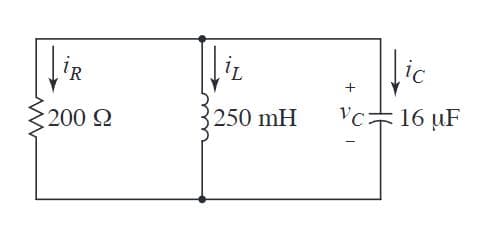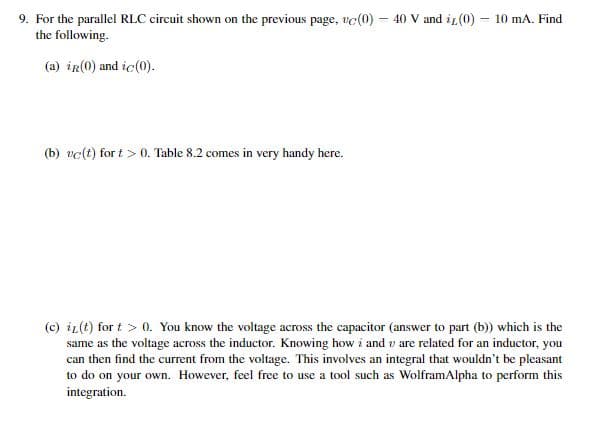iR 200 Ω 250 mH ic + VC 16 uF 9. For the parallel RLC circuit shown on the previous page, vc(0) - 40 V and iz (0) the following. (a) in(0) and ic(0). (b) uc(t) for t>0. Table 8.2 comes in very handy here. - 10 mA. Find (c) i(t) fort >0. You know the voltage across the capacitor (answer to part (b)) which is the same as the voltage across the inductor. Knowing how i and v are related for an inductor, you can then find the current from the voltage. This involves an integral that wouldn't be pleasant to do on your own. However, feel free to use a tool such as WolframAlpha to perform this integration.
iR 200 Ω 250 mH ic + VC 16 uF 9. For the parallel RLC circuit shown on the previous page, vc(0) - 40 V and iz (0) the following. (a) in(0) and ic(0). (b) uc(t) for t>0. Table 8.2 comes in very handy here. - 10 mA. Find (c) i(t) fort >0. You know the voltage across the capacitor (answer to part (b)) which is the same as the voltage across the inductor. Knowing how i and v are related for an inductor, you can then find the current from the voltage. This involves an integral that wouldn't be pleasant to do on your own. However, feel free to use a tool such as WolframAlpha to perform this integration.
Chapter19: Special-purpose Outlets-water Pump, Water Heater
Section19.2: Water Heater Branch Circuit
Problem 9R: An 80-gallon electric water heater has 60F (15.56C) incoming water. How many minutes can a...
Related questions
Question

Transcribed Image Text:iR
200 Ω
250 mH
ic
+
VC 16 uF

Transcribed Image Text:9. For the parallel RLC circuit shown on the previous page, vc(0) - 40 V and iz (0)
the following.
(a) in(0) and ic(0).
(b) uc(t) for t>0. Table 8.2 comes in very handy here.
-
10 mA. Find
(c) i(t) fort >0. You know the voltage across the capacitor (answer to part (b)) which is the
same as the voltage across the inductor. Knowing how i and v are related for an inductor, you
can then find the current from the voltage. This involves an integral that wouldn't be pleasant
to do on your own. However, feel free to use a tool such as WolframAlpha to perform this
integration.
Expert Solution
This question has been solved!
Explore an expertly crafted, step-by-step solution for a thorough understanding of key concepts.
This is a popular solution!
Trending now
This is a popular solution!
Step by step
Solved in 1 steps

Recommended textbooks for you

EBK ELECTRICAL WIRING RESIDENTIAL
Electrical Engineering
ISBN:
9781337516549
Author:
Simmons
Publisher:
CENGAGE LEARNING - CONSIGNMENT

EBK ELECTRICAL WIRING RESIDENTIAL
Electrical Engineering
ISBN:
9781337516549
Author:
Simmons
Publisher:
CENGAGE LEARNING - CONSIGNMENT